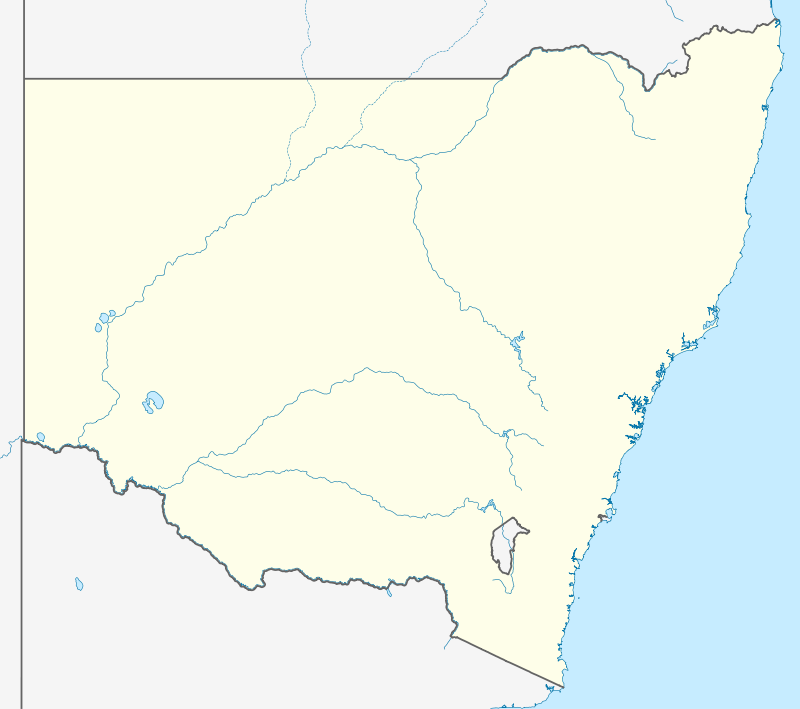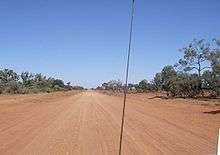Wilcannia
Wilcannia is a small town located within the Central Darling Shire in north western New South Wales, Australia. This was the third largest inland port in the country during the great river boat era of the mid-19th century.[3] At the 2016 census, Wilcannia had a population of 549.[1]
| Wilcannia New South Wales | |||||||||
|---|---|---|---|---|---|---|---|---|---|
Central Darling Council Chambers | |||||||||
 Wilcannia | |||||||||
| Coordinates | 31°33′25″S 143°22′45″E | ||||||||
| Population | 549 (2016 census)[1] | ||||||||
| Established | 1866 | ||||||||
| Postcode(s) | 2836 | ||||||||
| Elevation | 75.0 m (246 ft) | ||||||||
| Location | |||||||||
| LGA(s) | Central Darling Shire | ||||||||
| County | Young County | ||||||||
| State electorate(s) | Barwon | ||||||||
| Federal Division(s) | Parkes[2] | ||||||||
| |||||||||
History
The area lies in the traditional lands of the Barkindji people, who call the river "Baaka".[4] The name Wilcannia is said to be derived from an Aboriginal term for either "gap in the bank where floodwaters escape" or "wild dog". Neither meaning has been linguistically verified.[3]
In 1835, explorer Major Thomas Mitchell was the first European to the region, in which he traced the Darling River to what is now Menindee.[5] In June 1866, the township of Wilcannia was proclaimed.[5] In 1871, the population was 264, and grew to 1,424 by 1881.[6] During the 1880s, Wilcannia reached its peak, and had a population of 3000 and 13 hotels and its own newspaper,[5] the Western Grazier. It was, with Wentworth, Echuca, Mannum and Goolwa, one of the major Murray-Darling river ports which played a vital part in the transport of goods, notably wool and wheat, in the days of the paddle-steamers.
A visitor to the town described the river scene in 1890.
There are several wharves (so-called) which were merely graduated slopes cut out of the river bank, and in the wool season the river, in their vicinity, is thronged with steamers and barges, waiting for or unloading the season's clip, for the bulk of it goes away either to Bourke, for Sydney, or to Wentworth, or Goolwa. A barge, laden withfrom 1,200 to 2,000 bales of wool is a pretty sight; and a still more interesting spectacle is a string of 30 or 40 camels, each carrying two bales, proceeding into town from some far back station.[7]
Geography
Wilcannia is located where the Barrier Highway crosses the Darling River, 965 kilometres (600 mi) from Sydney. The environment is borderline semi-arid to desert with an annual rainfall of 255 millimetres (10.0 in). Wilcannia is located within the Darling Riverine Plains Bioregion (IBRA classification, Department of Environment), consisting of landscapes adapted to flooding. Common species include River Red Gum, Yellow Box, Oldman Saltbush and Lignum.
The surrounding area is very sparsely settled by pastoralists who have large land holdings, used primarily to run sheep. These holdings fall in the Western Division and the majority are held as 99-year leases.
Climate
Wilcannia has a semi-arid climate with hot summers and mild to cool winters. Mean maximum daily temperature in summer is 34 °C and in winter is 19 °C. The highest temperature recorded in Wilcannia was 50.0 °C (122.0 °F) on 11 January 1939.[8] This was during the severe heatwave of January 1939.
| Climate data for Wilcannia (Reid Street) | |||||||||||||
|---|---|---|---|---|---|---|---|---|---|---|---|---|---|
| Month | Jan | Feb | Mar | Apr | May | Jun | Jul | Aug | Sep | Oct | Nov | Dec | Year |
| Record high °C (°F) | 48.2 (118.8) |
47.1 (116.8) |
44.4 (111.9) |
38.4 (101.1) |
31.3 (88.3) |
29.3 (84.7) |
30.6 (87.1) |
32.4 (90.3) |
39.4 (102.9) |
40.7 (105.3) |
45.2 (113.4) |
46.8 (116.2) |
48.2 (118.8) |
| Average high °C (°F) | 35.4 (95.7) |
34.6 (94.3) |
31.3 (88.3) |
26.2 (79.2) |
21.2 (70.2) |
17.7 (63.9) |
17.1 (62.8) |
19.5 (67.1) |
23.5 (74.3) |
27.4 (81.3) |
31.2 (88.2) |
33.9 (93.0) |
26.6 (79.9) |
| Average low °C (°F) | 19.8 (67.6) |
19.3 (66.7) |
16.2 (61.2) |
11.7 (53.1) |
7.9 (46.2) |
5.4 (41.7) |
4.2 (39.6) |
5.6 (42.1) |
8.4 (47.1) |
12.2 (54.0) |
15.6 (60.1) |
18.2 (64.8) |
12.0 (53.6) |
| Record low °C (°F) | 9.2 (48.6) |
8.8 (47.8) |
6.4 (43.5) |
1.8 (35.2) |
−2.5 (27.5) |
−2.8 (27.0) |
−5.0 (23.0) |
−3.3 (26.1) |
−0.5 (31.1) |
3.4 (38.1) |
3.9 (39.0) |
8.4 (47.1) |
−5.0 (23.0) |
| Average rainfall mm (inches) | 25.9 (1.02) |
26.5 (1.04) |
24.7 (0.97) |
17.1 (0.67) |
23.6 (0.93) |
22.2 (0.87) |
18.4 (0.72) |
17.5 (0.69) |
15.9 (0.63) |
25.2 (0.99) |
20.9 (0.82) |
26.0 (1.02) |
263.9 (10.39) |
| Average precipitation days | 2.9 | 2.9 | 2.7 | 2.7 | 4.1 | 4.6 | 4.4 | 4.2 | 3.4 | 4.0 | 3.4 | 3.2 | 42.5 |
| Source: Bureau of Meteorology[9] | |||||||||||||
Significant weather
On 9 November 1950, a severe thunderstorm with damaging winds and large hail the size of cricket balls struck the town. Two people were injured, dozens of homes lost their roofs and nearly every house in town was damaged due to the large hail.[10]
Demography
From the 2016 Census, Wilcannia had a population of 549 with 407 (74.4%) people being of Aboriginal or Torres Strait Islander descent, mostly from the Barkindji nation.[11] Wilcannia has 223 private dwellings.[1] The town was listed as one of the most socially disadvantaged areas of New South Wales according to the 2015 Dropping Off The Edge report.[12]
Media
The town's social issues were highlighted in the BBC3 documentary Reggie Yates: Hidden Australia "Episode 1: Black in the Outback", first broadcast online on 16 January 2017.[13] In March 2017 the BBC, in response to complaints about the biased and misleading view portrayed, investigated the claims and suspended the production company pending the outcome of the review.[14][15] In June 2017 the suspension was confirmed for 6 months, covering all new commissions and development. "It was a serious breach of the BBC's Editorial Guidelines and the high standards of accuracy and fairness we expect of programme makers," the BBC Trust stated. The BBC and Sundog both issued apologies.
In 2017, in a counter-response, ABC Radio National highlighted Wilcannia's other non-negative social aspects in a 6-part series called "Positively Wilcannia" by The Real Thing.[16]
Notable people
- Annie Moysey, known as Wilcannia's Grandmother.[17]
- The Wilcannia Mob, a hip-hop musical group of five Indigenous Australians.
Gallery
- from the bed of the Darling River
- Street Scene
- Street Scene
- Former warehouse now Residence and Art Studio
- Wilcannia Police Station with Melia azedarach
- Now a Pharmacy and residence 2016
- Residence near the Anglican Church
- Bridges over the Darling River
- Old Post Office
- Old warehouse
 The Bourke-Wilcannia road, near Bourke
The Bourke-Wilcannia road, near Bourke.jpg)
See also
References
- Australian Bureau of Statistics (27 June 2017). "Wilcannia (Urban Centre/Locality)". 2016 Census QuickStats. Retrieved 25 November 2017.
- "Profile of the electoral division of Parkes (NSW)". Australian Electoral Commission. 25 February 2016. Retrieved 12 July 2016.
- "Wilcannia". Geographical Names Register (GNR) of NSW. Geographical Names Board of New South Wales. Retrieved 24 July 2009.

- Volkofsky, Aimee (12 May 2020). "Indigenous community sets up camp on Darling River to avoid coronavirus risk in overcrowded homes". ABC News. Australian Broadcasting Corporation. Retrieved 13 May 2020.
- "Wilcannia – Culture and History". Fairfax Media. November 2008. Retrieved 25 March 2013.
- "NSW 1881 census page vii". Australian National University. Retrieved 25 March 2013.
- Philip Cox & Wesley Stacey (1973), Historic towns of Australia, Melbourne, Lansdowne, p.100. ISBN 0701801840
- "Year Book Australia 2009–10" (PDF). Australian Bureau of Statistics. p. 97. Retrieved 25 March 2013.
- "Wilcannia (Reid St)". Climate statistics for Australian locations. Bureau of Meteorology. March 2013. Retrieved 25 March 2013.
- "Hurricane And Hail Storm Lashes Far-western Town". The Sydney Morning Herald. National Library of Australia. 10 November 1950. p. 1. Retrieved 25 March 2013.
- https://theconversation.com/the-barkindji-people-are-losing-their-mother-the-drying-darling-river-57884
- Taylor, Josie; Branley, Alison. "Dropping Off The Edge: Select suburbs stuck in cycle of disadvantage with little being done to help, report shows". ABC News. Retrieved 25 July 2015.
- "BBC Three - Reggie Yates: Hidden Australia, Black in the Outback". BBC. Retrieved 27 March 2020.
- Wainwright, Sofie (8 June 2017). "BBC suspends relationship with producers of Wilcannia documentary". ABC News. Retrieved 27 March 2020.
- Davidson, Helen (8 March 2017). "BBC apologises for misleading documentary on 'drunken' Aboriginal community". The Guardian.
- "#16: Positively Wilcannia". ABC Radio National. 5 July 2017. Retrieved 27 March 2020.
- "The Most Beautiful Lady..." (PDF). New Dawn. 1 (10): 2–3. January 1971.
External links
![]()